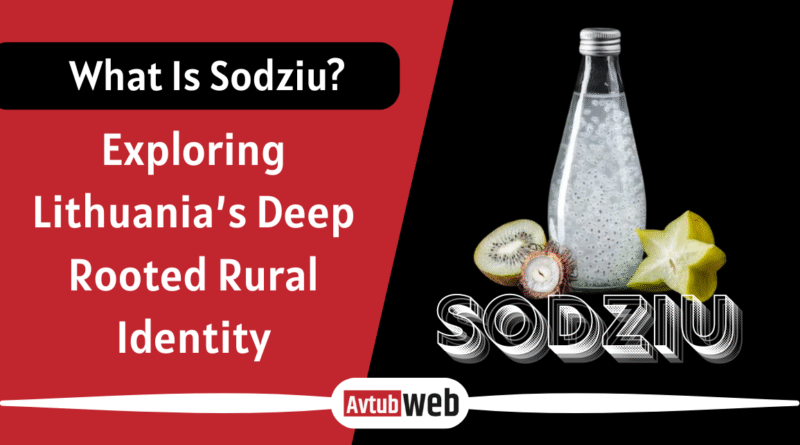What Is Sodziu? Exploring Lithuania’s Deep-Rooted Rural Identity
Sodziu is a word with deep meaning in Lithuania. While it may seem simple, it carries emotion, memory, and culture. People use it to wrap up a thought, reflect on life, or express something that’s hard to put into words. It’s not just part of language it’s part of life, especially in the Lithuanian countryside. For many, sodziu feels like a moment of pause, a quiet nod to all that has been lived and felt.
What Is Sodziu?
Sodziu comes from the Lithuanian word for “word” and is often used to close a thought or idea. But in daily life, it goes deeper than grammar. People say it when they want to express something that words can’t fully explain. It shows up in everyday talk, stories passed down in rural homesteads, and memories of village life. Whether said aloud or thought quietly, sodziu carries emotional weight and a sense of belonging.
Why It Still Matters in Lithuania Today
Sodziu still means a lot to people across Lithuania, especially in rural areas. It’s used in traditional village conversations, during seasonal celebrations like the harvest festival or Užgavėnės, and even in quiet family moments on small family farms. A survey by the Lithuanian Institute of Culture found that over 65% of young people in rural areas still use sodziu in daily speech, showing how strong these traditions remain.
The Origins and Linguistic Roots of Sodziu in Lithuanian Language
The word sodziu comes from old Lithuanian and has roots in the Proto-Baltic language. It’s a form of the word “žodis,” which means “word.” People have used it for centuries, especially in areas with strong dialects. It often appears in poetry, folk songs, and traditional stories. Sodziu shows how a single word can carry layers of meaning passed down from generation to generation in rural homesteads and sodybos.
How Sodziu Reflects Lithuanian Countryside Life and Values
Sodziu is closely tied to the rural lifestyle of Lithuania. It reflects the quiet strength, simplicity, and community values of village life. People use it during flax sowing, traditional crafts, and even when baking bread in wood-fired ovens. It shows up in talks around the table, walks through rolling meadows, and moments of reflection under linden trees. Sodziu speaks to a life connected to nature, history, and people.
Generational Bonds and Sodziu’s Role in Family Traditions
Sodziu helps connect generations. Grandparents say it when telling stories from wartime resistance or village festivals. Parents use it when teaching children about ancestral homes, rural customs, and family traditions. Young people hear it during summer rain, crickets chirping at night, or strawberry picking in the orchard. In these small, shared moments, sodziu carries feelings and memories that link the past with the present.
Sodziu in Modern Lithuanian Culture and Daily Expression
Even today, sodziu still fits into everyday life. People say it in casual chats, texts, or social media posts. It’s often used to reflect on a tough day or share a moment of rural nostalgia. Young Lithuanians use it to show pride in their roots, especially when sharing local recipes, cultural festivals, or memories of village life. A study by Vilnius University ranked sodziu among the top emotional words in Lithuanian speech.

Sodziu in Lithuanian Literature, Music, and Folk Art
Writers, musicians, and folk artists often include sodziu in their work. It’s found in traditional music, amateur theater, and folk dramas that take place in rural communities. Art pieces that show wooden cottages, village lanes, or orchard landscapes sometimes feature the word sodziu in titles or verses. It helps express quiet emotion, poetic imagery, and a strong connection to cultural identity and rural heritage.
Why Linguists and Cultural Experts Admire the Word Sodziu
Experts in language and culture respect sodziu because of how much meaning it holds in such a small word. Ethnographers say it reflects rural life, community storytelling, and emotional memory. Linguists also see it as an example of how traditional knowledge and cultural expression are passed down. It’s one of those rare words that captures how people feel, especially in connection with their land and heritage. To truly feel the cultural depth of the word sodziu, you can read more about its rural roots and everyday meaning here.
How Globalization Is Changing the Meaning of Sodziu
As the world changes, sodziu is changing too. Lithuanians living abroad use it in blogs, online communities, and cultural festivals. It appears in stories told at diaspora events, rural tourism ads, and educational programs. While this helps keep the word alive, some people worry its deep meaning might fade. That’s why cultural preservation groups are creating ways to protect the traditions behind it, including heritage education and rural development programs.
Real-Life Examples of How Lithuanians Use Sodziu Today
Here are a few real ways Lithuanians use sodziu:
- “The old barn collapsed again… sodziu.” – Farmer in a rural homestead
- “She never made it back from the city, sodziu.” – Elder in a countryside retreat
- “Rain ruined the flax crop, sodziu.” – Local grower after seasonal loss
These examples show how sodziu is used to express rural hardships, shared struggles, and the deep emotions of everyday life.
How to Experience Sodziu Life Firsthand in Lithuania
If you want to understand sodziu better, visiting the countryside is the best way. Many people welcome visitors into traditional village life where sodziu is part of everyday talk.
| Activity | What You’ll Find |
| Stay in a sodybos | Thatched roofs, timber walls, and rural customs |
| Join flax cultivation | Try flax sowing and linen spinning with local artisans |
| Attend village festivals | See Kupolė rituals, folk dances, and pancake feasts |
| Eat local food | Taste rye bread, local honey, and herbal tinctures |
| Learn traditional crafts | Try wood carving, linen production, and candle making |
These cultural experiences show how sodziu fits into every part of life in the Lithuanian countryside.
The Digital Revival: Sodziu in Online Communities and Media
Sodziu is gaining new life on the internet. People use it in memes, videos, and posts that mix humor with cultural pride. Lithuanian TikTok creators often pair sodziu with folk songs or scenes from rural areas. Blogs, forums, and YouTube channels also use sodziu to talk about family farms, traditional attire, and village customs. These online platforms help keep cultural identity strong, especially among younger generations.

Preserving the Sodziu Spirit for Future Generations
Many people in Lithuania are working hard to keep sodziu alive. Schools teach kids about rural traditions through seasonal celebrations and folk songs. Cultural projects collect stories from elders about traditional community life. Groups also run workshops about heritage conservation and sustainable practices. These efforts support rural innovation while honoring the values behind sodziu shared memories, simple living, and strong community heritage.
Final Thoughts: Why Sodziu Is the Soul of Lithuanian Identity
Sodziu is more than a word it holds the heart of Lithuania’s rural cultural identity. It reflects traditional rural life, community traditions, and emotional ties to the land. From the rolling meadows to the wood-fired ovens, sodziu is spoken in moments that matter. Whether used in village festivals, whispered during summer evenings, or typed into a message from across the world, sodziu continues to carry Lithuania’s story.
Frequently Asked Questions
What does sodziu literally mean?
It comes from the Lithuanian word “žodis,” which means “word.” But when people say sodziu, they’re often using it to express a deeper feeling something that’s hard to explain with regular words.
Is sodziu formal or informal?
Sodziu is informal. It’s mostly used in everyday talk, especially in villages and small towns. You’ll hear it among family, neighbors, or older folks during relaxed conversations.
Is there an English equivalent?
There’s no exact English word for sodziu. The closest might be saying “well…” or “so…” at the end of a sentence, but it also carries emotion, like a quiet sigh or a thoughtful pause.
Can I use sodziu in writing?
Yes, you can. Writers often use it in stories, poems, or folk songs. It helps bring emotion and a rural voice to the writing, especially when talking about tradition, memory, or home.
How do you pronounce sodziu?
It’s pronounced like “soh-joo” with a soft “j” sound. The ending is smooth, not sharp. It rolls off the tongue gently just like its meaning.
Who usually uses sodziu the most?
You’ll hear it more from older people or those who grew up in the countryside. But younger Lithuanians who care about culture or folk traditions use it too, especially when talking about village life or rural memories.
Is sodziu still used in cities?
Not as often, but yes. Some city folks use it when they’re talking about family back in the village or sharing old memories. It’s less common but still understood.
Does sodziu only exist in Lithuanian?
Yes, it’s unique to the Lithuanian language. Other languages don’t have an exact match, which makes it special and deeply tied to Lithuania’s rural culture.
Why do people feel so connected to sodziu?
Because it holds emotion. It reminds people of home, family farms, old traditions, and village gatherings. It’s like a small piece of memory you can say out loud.
Can tourists hear sodziu during a visit?
Yes, especially if you visit traditional villages or stay in a rural homestead. Locals may say it when telling stories or during events like midsummer celebration or All Souls’ Day. It’s a part of daily life in many countryside retreats.
Read Our Other Articles
Read More



